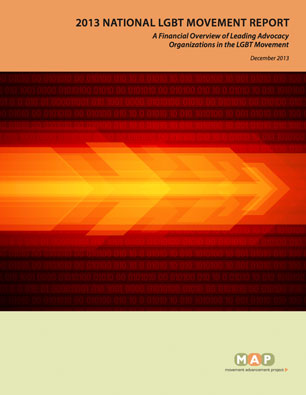The Bottom Line
The National LGBT Movement Report, published annually by MAP, examines revenue and expenses, fundraising and fundraising efficiency, and other indicators of financial health for lesbian, gay, bisexual and transgender (LGBT) social justice advocacy, issue, legal, research and public education organizations.
- 2013 National LGBT Movement ReportDownload
- 2012 National LGBT Movement ReportDownload
- 2011 National LGBT Movement ReportDownload
- 2010 National LGBT Movement ReportDownload
Abstract
The 2013 National LGBT Movement Report provides a comprehensive snapshot of the financial health of LGBT social justice advocacy organizations. The 36 organizations examined for the 2013 report collectively represent 61% of the budgets of all LGBT social justice advocacy organizations. Among the key findings in the 2013 report:
Revenue and Expenses. LGBT social justice organizations’ revenues exceeded expenses by $3.2 million in 2012, and the 4% growth in revenue from 2011 to 2012 slightly outpaced the national average for all nonprofits of 3.2%. The increased revenue in 2012 marks two years of growth after a two-year revenue decline in 2009 and 2010. Although revenues are still not back up to 2008 levels, the last two years of growth indicate that the LGBT nonprofit sector, like the American economy, is experiencing a slow but steady recovery after the recent economic downturn. Participating organizations are projecting combined 2013 expense budgets of $165.6 million, a 10% increase from 2012 expenses.
Fundraising and Fundraising Efficiency. Fundraising and individual donations continue to increase, with a notable spike in government funding due to several organizations receiving large grants, likely due to the Obama Administration’s increased awareness of and attention to LGBT issues. Movement groups are highly efficient in their fundraising and programming operations. On average, 81% of total expenses are dedicated to programs and services —exceeding benchmarks of the American Institute of Philanthropy and Better Business Bureau Wise Giving Alliance.
Other Indicators of Financial Health. General financial health remains strong. In 2012, organizations reported an average of nearly six months of available working capital.
Staff and Boards. The racial and ethnic diversity of paid staff at participating organizations is slightly less than that of the overall population: 32% of paid staff identify as people of color compared to 37% of the U.S. population. Forty-six percent (46%) of staff identified as women, and 7% percent of staff identified as transgender.
2013 Participating Organizations
ACLU LGBT & AIDS Project
Basic Rights Oregon
CenterLink
Empire State Pride Agenda
Equality California
Equality Federation
Equality Florida
Family Equality Council
Freedom to Marry
Funders for LGBTQ Issues
Gay & Lesbian Advocates & Defenders (GLAD)
Gay & Lesbian Victory Fund and
Leadership Institute
Gay, Lesbian and Straight Education Network (GLSEN)
Gay-Straight Alliance Network
GLAAD
Human Rights Campaign and Foundation (HRC)
Immigration Equality
Keshet
Lambda Legal
Log Cabin Republicans
MassEquality
National Black Justice Coalition (NBJC)
National Center for Lesbian Rights (NCLR)
National Center for Transgender Equality (NCTE)
National Queer Asian Pacific Islander Alliance (NQAPIA)
New York City Gay and Lesbian Anti-Violence Project
Out & Equal Workplace Advocates
Parents, Families and Friends of Lesbians and Gays (PFLAG)
Point Foundation
Services & Advocacy for GLBT Elders (SAGE)
Soulforce
Sylvia Rivera Law Project
The Task Force
Transgender Law Center
The Trevor Project
(One organization preferred not to be listed.)



